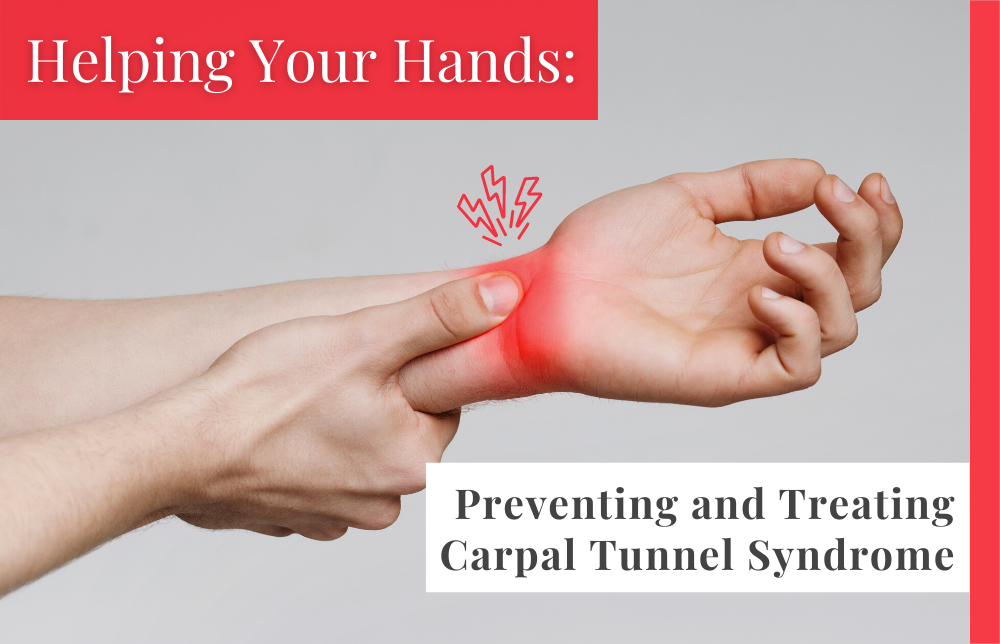
Helping Your Hands: Preventing and Treating Carpal Tunnel Syndrome
July 26, 2022
Ever notice your hands feel weak and tingly after a day typing away at the keyboard? This could be a symptom of carpal tunnel syndrome.
An estimated 4 to 10 million Americans have carpal tunnel syndrome, or CTS. Though symptoms start gradually, such as a tingling or mild weakness in in the hand and wrist, if left untreated, CTS can lead to permanent nerve damage with symptoms including permanent loss of sensation and weakening of muscles in the hand. It can also cause pain in the forearm and in severe cases cause the muscles in the palm and thumb to atrophy.
Causes of Carpal Tunnel Syndrome
Repetitive tasks, such as typing on a computer or smartphone, driving, playing an instrument, sewing, and others are the most frequent cause of CTS. But other factors also play a role, such as:
- Prior wrist or hand injury
- Hereditary
- Medical conditions like hypothyroidism, obesity, diabetes, high blood pressure, and rheumatoid arthritis.
Women run a 3x greater risk of developing CTS.
Preventing and Treating Carpal Tunnel Syndrome
The best way to prevent CTS is with a combination of wrist exercises, nutrition, and using ergonomically designed tools to protect your hands.
Wrist exercises
This exercise is effective to keep your hand flexible to prevent CTS or to treat symptoms.
- Raise your right hand parallel to the floor. Bend the wrist so your palm faces in and your fingers point down. Use your left hand to hold your right hand’s wrist gently. You should feel a stretch in the back of the wrist and even up the back of your forearm. Switch hands.
- Raise your right hand parallel to the floor. This time, bend the wrist so your palm faces out and fingers point up (it should look like you’re making a stop sign). With your left hand, hold the inside of your fingers and gently pull towards you. Switch and perform the same exercise on the other hand.
Nutrition
Inflammation is one of the main factors in CTS. Avoid or limit salt, sugar, or processed foods which can exasperate inflammation. On the other hand, foods high in antioxidants may help reduce inflammation. These include tuna, salmon, dark green or bright red veggies, and walnuts. Chicken, avocadoes, spinach, and bananas - which are high in Vitamin B6 - are also beneficial.
- Ergonomic Solutions
Ergonomic keyboards, chairs and even scissors and knives can help minimize the stress and strain on your hands and wrists. Of course, paying to attention to your posture and remembering to take regular breaks also helps.
If the condition is severe enough, a minor outpatient procedure may be necessary. But knowing the causes and the symptoms of CTS can go a long way to keep you healthy.
Another way to make sure you stay healthy is by having all the insurance benefits you should. Set up a FREE Benefits Review with a skilled AMBA representative today. Our caring agents are here to help you review options and determine the right coverage for you—whether it’s dental insurance, vision plans, or other policies. Request a FREE Benefits Review with an AMBA field agent at www.amba-review.com or call 866-615-4063 Mon.-Fri 8am-5pm CT.
Source: https://www.mountsinai.org/health-library/diseases-conditions/carpal-tunnel-syndrome
RECENT POSTS
AMBA’s Essential Insights in Dental Health: Understanding Cavities
Have you ever experienced pain or noticed persistent sensitivity in your teeth? You might have a cavity. Cavities are common,
Read More
Keep “Looking” Your Best: The Unique Eye Health Challenges for Women Over 55
March is Women’s History Month, a time to celebrate women's contributions to American history and society. It’s
Read More

Leaving Your Home To A Loved One
If you’re like many people, your home represents more than just financial value. As the saying goes, "Home is where the
Read More

The Top Scams to Watch Out for in 2025
In our increasingly digital world, the top scams continue to evolve, with fraudsters developing new and sophisticated ways to
Read More

